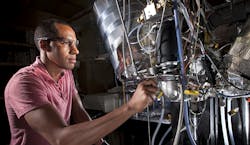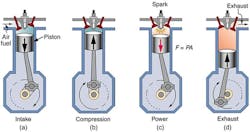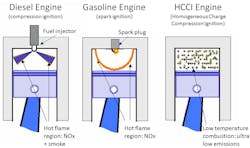Low-Temp Gasoline Combustion Research Could Boost Engine Efficiency
Low-temperature gasoline combustion (LTGC) is an attractive topic for engine research because the reduction in heat transfer improves engine performance and reduces nitrous oxide emissions. At the Combustion Research Facility (CRF) at Sandia National Labs, researchers conduct a range of investigations to understand the chemistry of combustion in LTGC engines. They work with industry partners and other national labs to explore clean engine designs for various fuels. The ultimate goal of the research at CRF is to design auto-ignition methods for future automotive engines that could be used to replace spark plugs found in conventional internal combustion motors.
âA recent project explores a negative valve overlap (NVO) system with modified valve timings to trap some exhaust in the combustion chamber at the end of each duty cycle. The exhaust mixes with an injected fuel stream to create a charged product that ignites at low flame temperatures. During the engine's compression stroke, heat transfer causes the new dilute charged mixture to ignite. The released energy drives the power stroke. A shortened exhaust stroke and delayed opening of the intake valve allows for a portion of the exhaust to remain in the chamber again for the next cycle. The team designed the NVO system to try and improve combustion stability at low loads. This instability is one of the reasons that LTGC is challenging for engine designs.
The scientists use a variety of tests and modeling tools to try and understand the chemical combustion reaction in dilute exhaust/fuel mixtures. Understanding the chemistry and constituents of mixtures (in addition to thermodynamic properties) over the duty cycle may help to control combustion in all conditions. Recently, CRF announced that it has formed a Spray Combustion Consortium to pool resources that can be used to explore alternate fuel injection methods.
The scientists tested six different types of fuels to determine their constituents after combustion and their reaction with the exhaust. They tested iso-octane, n-heptane, ethanol, cyclohexane, toluene, and 1-hexene to represent components found in commercial gasoline. Research-grade gasoline and a surrogate with a known composition were also tested using single-cylinder research engines. A dump sampling valve was set up to send samples in the combustion chamber to a gas chromotograph, which identifies light hydrocarbon components in the mixture.
To distinguish between hydrocarbon species with similar molecular composition but different effects on the chemistry of combustion, a photo-ionization mass spectroscopy technique was performed using Lawrence Berkeley National Laboratory's Advanced Light Source. The team found that during compression, the mixture's high temperatures cause the fuel to decompose into a reactive “reformate” mixture made up of highly combustible constituents like hydrogen, carbon monoxide, and small hydrocarbons like methane, acetylene, and ethylene.
LTGC is also known as Homogeneous Charge Compression Ignition (HCCI) and Premixed Charge Compression Ignition (PCCI).
About the Author
Leah Scully
Associate Content Producer
Leah Scully is a graduate of The College of New Jersey. She has a BS degree in Biomedical Engineering with a mechanical specialization. Leah is responsible for Machine Design’s news items that cover industry trends, research, and applied science and engineering, along with product galleries. Visit her on Facebook, or view her profile on LinkedIn.


